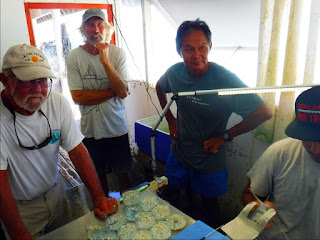We
learned early when we arrived in French Polynesia, that the most
beautiful of all the pearls, comes from the Gambier Islands. Maybe
because of the cooler water, maybe because of the clarity of the
lagoon, but Robert Wan is headquartered here and owns part of the
island of Aukena.
We
had heard about a man named Eric, who was a cruiser friendly pearl
farm. Many of the farmers, especially Wan, are not cruiser friendly
and does not want us around. Funny thing, Eric turned out to be
Wan's nephew, who had run his farm for him for many years. Then he
married a beautiful Polynesian woman named Tina and they opened their
own pearl farm.
On
the NE side of the outer motus of the Gambiers is a spot known as the
“False Pass”. This is a place where the sea has broken through
the reef, but the water is not deep enough for a boat to pass through
it. Hense the falseness of it. Eric and Tina's house is located
just on the East side of the False pass.
They
have a magnificent beautiful beach.
As
you move farther East along the motu, you come upon their pearl farm
business.
As
we motored toward their side of the island, this is what the bottom
contour looks like. Somewhat steep in places, where coral comes
close to the surface.
As
we arrived the men were removing the oysters from their plastic mesh
holding system. This is step one after they are brought ashore by
the divers. Of course, you also should know, those oysters have been
out there working for a minimum of 18 months making pearls.
The
oyster shells are attached to their “cage” with a plastic zip
tie. Then the top is brought over them and they are sealed in place
by the big plastic mesh.
The
oysters are placed in a plastic crate and brought inside the red
pointed roofed building.
Here
they pump sea water over them while they wait, to keep them alive.
The
oysters are then sorted.
This
lady does the sorting and organizes the oysters for the surgeons.
She
opens each one, using gloved hands so not to scratch herself on the
sharp edges.
She
places a wedge in each one to keep it open. This is no small feat,
as the oyster muscles are quite strong!
She
places them in bins for each of the surgeons.
This
is Eric's #1 surgeon, operating at his work station. He can remove
more pearls per hour than any of the other surgeons.
He
places that tool next to the wedge and forces the shell open a bit
more so he can perform his surgery.
Then
he uses his tools to find and extract the pearl.
The
pearl is placed on his work mat where he finds a new nucleus to place
inside the pearl. It has to match the size of the pearl that was
removed.
He
chooses a different one.
After
placing the nucleus back in the same spot, he releases the shell back
to closed.
Our
#2 man is close behind and also does very good work.
He
allows me to get a closer look of how his tool works, locking the
shell in an open position.
His
view of the oyster.
My
camera captures just the right light to see the pearl reflecting down
inside.
He
uses this blue starboard plate to hold his tools and size up his
pearl. The tool on the right works like a suction cup to hold the
pearl while removing it.
He
also has these tongs for the more difficult ones to remove.
The
white buckets have cleansing sea water and removed pearls. Each of
the white nucleus's are pre sized for easy picking.
They
are just smooth plastic balls which the pearl shell grows on, but
they look like a bunch of marbles.
Sizing
up a nucleus with a removed pearl.
Inside
the pearl bucket, you can see that no two are alike, in either shape,
size or color.
The
girls working in the next room, also performing the surgery.
Mike,
Marcus and our host Eric, discussing the process.
Eric
explains the anatomy of an oyster. Not all oysters can be re-used
for growing another pearl, but they average 3-5 useages per oyster.
(that is times 18 months each in the water)
The
nucleus is placed inside the gonads of the oyster (OUCH!) Then the
oyster uses its muscle to roll the nucleus around on its shell. You
can see the color of the rainbow inside the oyster's shell. So
depending on which color the oyster rubs the nucleus on, is what
decides what color that pearl will be.
When
an oyster is damaged or not able to be used again for pearl making,
it goes into this pile.
Oysters
waiting to be de shelled.
Our
first man is the same one who cleans the oysters.
Once
cleaned just the muscle remains on the shell.
When
the muscle is removed, it is put in this vat of salt water to be
cleaned, washed, then EATEN!!
The
empty shells after all has been removed.
The
shells are then bagged in these black bags and shipped back to Tahiti
on the supply boat.
The
shells are bought by various suppliers in Tahiti and sold for art
work. When we got married in Mo'orea, back in 2016, we bought these
shells as gifts for our guests. Some shells are carved by hand into
various shapes or animals, but ours are etched with a machine, custom
for us.
So
there you have it, the many colors of the life of a Black Lipped
Oyster. From beginning of life, through work of pearl making, to
being dinner (yummy by the way!) and to beautiful art work like this.
Mauruuru (Thank you in Polynesian) Mr. Oyster!!





















































